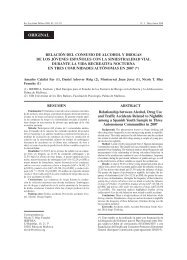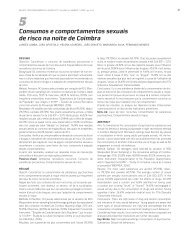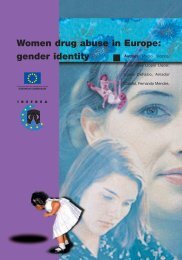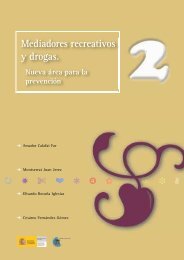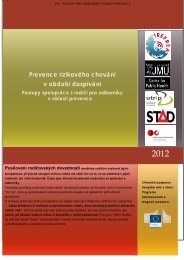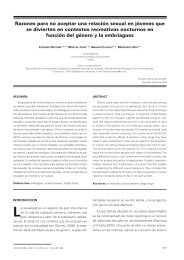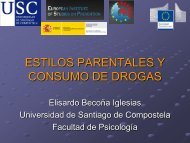Nowadays, three studies are be<strong>in</strong>g carried out <strong>in</strong> France:Two studies f<strong>in</strong>anced by “l’ Observatoire Français des Drogues et desToxicomanies” (OFDT) started <strong>in</strong> March, 1997, <strong>in</strong> the area <strong>of</strong> Paris-Lille <strong>and</strong> Bordeaux,directed by the C.E.I.D. (Centre d’Etude et d’Information sur la Drogue-Centre duParlament Sa<strong>in</strong>t Pierre, 24 rue du Parlament Sa<strong>in</strong>t Pierre - 33000 Bordeaux -Tel.0556448486 - Responsible: Jean Michel DELISLE) <strong>and</strong> the I.R.E.P. (Institut deRecherches en Epidémiologie de la Pharmacodépendance - 34 rue Jean Cott<strong>in</strong> - 75018Paris - Tel. 0146071029 - Responsible: Rodolph INDOLD).In Bordeaux, the study is carried out with data collected from an “exchange syr<strong>in</strong>gebus”, from a hundred drug users who usually go to the “ Centre du Parlament Sa<strong>in</strong>tPierre”, or directly found by pr<strong>of</strong>essionals <strong>of</strong> the centre or by “<strong>in</strong>formers” <strong>of</strong> any <strong>of</strong> theplaces studied <strong>in</strong> the research (seven night-parties <strong>in</strong> the centre <strong>of</strong> Bordeaux -three <strong>of</strong>them <strong>of</strong>ficial- organised by music shops, a private night-party <strong>in</strong> the centre <strong>of</strong> Bordeaux,two “wild” parties <strong>in</strong> the outskirts <strong>of</strong> Bordeaux). The first results show a youngpopulation (80% < 25 years old), more than 30% <strong>of</strong>ten go to raves, 80% associate tothis the use <strong>of</strong> drugs, 81% appreciate their effects <strong>and</strong> consume <strong>in</strong> order to try (73%),just 20% consider <strong>ecstasy</strong> sometimes has negative effects…In Paris <strong>and</strong> Lille, data are collected from 163 <strong>in</strong>dividuals recruited with thesnowball technique, <strong>in</strong> many different places <strong>and</strong> establishments, but, above all, <strong>in</strong> adisco at the frontier, near Lille. The aim <strong>of</strong> the study is to describe consumption, ways<strong>of</strong> life <strong>of</strong> drug users <strong>and</strong> groups (raves, discos, gay circles, nomads, sound system…Afirst observation is that <strong>ecstasy</strong>, <strong>in</strong> the raves <strong>and</strong> discos that have been visited, isnoth<strong>in</strong>g but a product among others, used by a young population (mean age is 26 yearsold), with a certa<strong>in</strong> <strong>representation</strong> <strong>of</strong> women (37%), <strong>social</strong>ly <strong>in</strong>tegrated (45% receiv<strong>in</strong>ga salary, 33% students, 20% liberal pr<strong>of</strong>essions, hav<strong>in</strong>g f<strong>in</strong>ished university studies…).Both reports have to be sent to the O.F.D.T. at the end <strong>of</strong> the year.Another project, prepared by Médec<strong>in</strong>s du Monde (MDM- Espace Parmentier, 62bis, Av. Parmentier- 75011 PARIS- Tel. 0143148161- Responsible: Christian SUEUR<strong>and</strong> Bertr<strong>and</strong> LEBEAU), with<strong>in</strong> their programme <strong>of</strong> drug addiction risks reduction, isentitled Research-Strategy-Prevention: new drugs, new uses- Ecstasy, LSD <strong>and</strong>dance-pills. It carries out three different strategies <strong>in</strong> parallel: prevention, research <strong>and</strong>sanitary assistance, <strong>in</strong> three raves a month <strong>in</strong> high season (summer 1997 <strong>and</strong> 1998) <strong>and</strong>two raves a month <strong>in</strong> low season, <strong>in</strong> the Ile <strong>of</strong> France, Midi-Pyrénées, Lyon, Strasbourg,Nice, Montpellier… at the same time.There are two books that quite expla<strong>in</strong> this phenomenon: E as Ecstasy by N.SAUNDERS” (Paris- Ed. Lézard, 1996), translated from English <strong>and</strong> published <strong>in</strong>France <strong>in</strong> 1996, <strong>and</strong> more recently Raver by Astrid FONTAINE <strong>and</strong> Carol<strong>in</strong>eFONTANA (Paris, Anthropos, Coll. Poche Ethno-Sociologie, October 1996) who writethe follow<strong>in</strong>g:“For all those who regularly “go out”, rave has a sense, a particular spirit. If welisten to them, it is not a question <strong>of</strong> violence or destruction, but <strong>of</strong> celebrations,132
delirious music <strong>and</strong> dance, a question <strong>of</strong> feel<strong>in</strong>g well <strong>and</strong> magical pills, smiles, meet<strong>in</strong>gs(…) everyth<strong>in</strong>g seems to turn on “gett<strong>in</strong>g <strong>in</strong>to the party” or not, with or without anydrug…”.Nevertheless, to take psychotropics “like <strong>in</strong> certa<strong>in</strong> traditional religious <strong>in</strong>itiations”,is <strong>of</strong>ten <strong>in</strong>dispensable <strong>and</strong> “seeks to break the <strong>social</strong> personality”, to break ord<strong>in</strong>aryreality, to “travel”, expla<strong>in</strong> the authors <strong>in</strong> their book. For both <strong>of</strong> them, the first,researcher <strong>in</strong> the laboratory <strong>of</strong> <strong>social</strong> dances, the second, ethnologist, “<strong>in</strong> the return totrance-celebrations” we see the opposition to a culture that supports all the ideologiesone does not believe anymore(…). Ravers try to escape from the world <strong>of</strong> rules <strong>and</strong>values <strong>and</strong> to get out <strong>of</strong> themselves, away from everyth<strong>in</strong>g that conditions them. Tranceis a way, the end <strong>of</strong> censures gives way to a clear conscience. This <strong>in</strong>tegratedexperience, could become a rite <strong>of</strong> passage”.“Integrated” prevention strategies for <strong>ecstasy</strong> use should take <strong>in</strong>to account this book“Raver”, full <strong>of</strong> <strong>in</strong>terest<strong>in</strong>g observations <strong>and</strong> thoughts, especially its analysis <strong>of</strong> technomusic, which allows a constructive underst<strong>and</strong><strong>in</strong>g <strong>of</strong> this “‘wild celebration, ‘out <strong>of</strong>culture’, that mixes symbols, times, religions, exalts utopian factors (...). The Techno,beyond its celebrations, would end <strong>in</strong>to a global “techno” culture, go<strong>in</strong>g together withthe myths <strong>of</strong> our age. And so, ”ravers” risk to be recaptured by the society they aretry<strong>in</strong>g to run away from. A society <strong>of</strong> appearances, lies, consume, that as soon as tak<strong>in</strong>gthe control <strong>of</strong> raves, would br<strong>in</strong>g stereotyped attitudes <strong>and</strong> transform them <strong>in</strong>toregulated celebrations without “spirit”. And noth<strong>in</strong>g would rema<strong>in</strong> <strong>of</strong> raves but theirname”.Must prevention strategies <strong>of</strong> the Public Adm<strong>in</strong>istration contribute to this process <strong>of</strong>st<strong>and</strong>ardisation?This k<strong>in</strong>d <strong>of</strong> drug starts to appear <strong>in</strong> medical literature at the beg<strong>in</strong>n<strong>in</strong>g <strong>of</strong> then<strong>in</strong>eties, when the first medical <strong>and</strong> psychological problems arise. (SUEUR C.Psychotropic drugs <strong>in</strong> So<strong>in</strong>s psychiatriques, 1991, 545). In 1994, a number <strong>of</strong> the“Revue documentaire du réseau de documentation spécialisé Toxibase” was dedicatedto <strong>ecstasy</strong> <strong>and</strong> po<strong>in</strong>ted out the <strong>in</strong>ternational literature on the subject (ANGEL P.Ecstasy, Toxibase, Revue Documentaire, 1994, 2, 1-10).Later, R. CAMMAS, psychiatrist <strong>of</strong> the Marmottan hospital, studied <strong>ecstasy</strong> <strong>in</strong> hisdoctorate thesis, <strong>in</strong> October 1995 (R. CAMMAS: Ecstasy: a new drug. Frompharmacology to Dream. Thesis <strong>of</strong> doctorate <strong>in</strong> Medic<strong>in</strong>e. Paris, 1995). The same year,a collective article by A. TRAGUI, GHYSEL J.H., KINTZ P., MANGIN P., entitledEcstasy, Eve, speed…the new stimulants <strong>of</strong> vigilance <strong>and</strong> love, was published <strong>in</strong> leJournal de Médec<strong>in</strong>e Légale, Droit Médical, 1995. The follow<strong>in</strong>g year, a group <strong>of</strong>practitioners, D. TOUZEAU <strong>and</strong> others, wrote: Ecstasy: myth <strong>and</strong> reality, <strong>in</strong> La Revuedu Praticien, Médec<strong>in</strong>e Libérale (April, 1996).In this same year, it was published a special number <strong>of</strong> the Revue Interdépendance:Ecstasy (September-October 1996). F<strong>in</strong>ally, L’Express published a dossier: Thedangerous passions (From hero<strong>in</strong>e to hashish: refus<strong>in</strong>g to hierarchize the pleasures that133
- Page 3 and 4:
ORGANISATIONS AND NATIONAL RESEARCH
- Page 5 and 6:
This volume is dedicated very speci
- Page 7 and 8:
PRESENTATIONIt’s a great pleasure
- Page 9 and 10:
INDEXPág.1. INTRODUCTION . . . . .
- Page 11 and 12:
1. INTRODUCTION1.1. DESIGNER DRUGS,
- Page 13:
the most widely used because its ef
- Page 16 and 17:
All this led to the famous English
- Page 18 and 19:
had used it in the preceding month.
- Page 20 and 21:
had used ecstasy or a similar subst
- Page 22 and 23:
school population found a prevalenc
- Page 24 and 25:
isk factors among adolescents (Cala
- Page 26 and 27:
make quantitative what is qualitati
- Page 28 and 29:
concentrated in ecstasy use. A stud
- Page 30 and 31:
the others versions but with less i
- Page 33 and 34:
3. SAMPLE DESIGN AND FIELD WORK3.1.
- Page 35 and 36:
Two different methods were suggeste
- Page 37 and 38:
according to drug use level. Finall
- Page 39 and 40:
We came into contact with eight ind
- Page 41 and 42:
4. SOCIODEMOGRAPHIC BACKGROUNDINTRO
- Page 43 and 44:
We did not think it would be necess
- Page 45 and 46:
STUDY LEVEL (% on global sample; %
- Page 47 and 48:
In Utrecht, most of the young peopl
- Page 49:
SUMMARYWe remind again that, in spi
- Page 52 and 53:
This classification will be used fr
- Page 54 and 55:
Montagne, 1992) or Rimini, in Italy
- Page 56 and 57:
RELIGION PRACTITIONER (% on global
- Page 58 and 59:
It stands out the high percentage o
- Page 60 and 61:
Amphetamines are often used with fr
- Page 62 and 63:
In the Utrecht sample, however, alt
- Page 64 and 65:
GLOBAL SAMPLE ANSWERSThe most popul
- Page 66 and 67:
These data are interesting in order
- Page 68 and 69:
WITH WHOM TO CONSUME ECSTASY? (In %
- Page 70 and 71:
As we have already seen in other ta
- Page 73 and 74:
6. SENSATION SEEKING SCALE (SSS)6.1
- Page 75 and 76:
correlation’s varies in function
- Page 77 and 78:
consumers sample comprises individu
- Page 79 and 80: DISINHIBITION (DIS)Modena, Palma an
- Page 81 and 82: y the non-consumer groups. In addit
- Page 83 and 84: Once again, on the Boredom Suscepti
- Page 85: this new scale. The individuals bel
- Page 88 and 89: Still following psychoanalysis, Koh
- Page 90 and 91: seeking scale, the hypotheses for t
- Page 92 and 93: SDS results according to sexSexPunc
- Page 94 and 95: understanding and explaining realit
- Page 96 and 97: there would be two more or less dif
- Page 98 and 99: RELATION BETWEEN ECSTASY AND SEXThe
- Page 100 and 101: of medicaments. In fact, they are p
- Page 102 and 103: In any case, it is true indeed that
- Page 104 and 105: Well aware that these interpretatio
- Page 106 and 107: with others, facilitates being able
- Page 108 and 109: 8.3.2. Social Representation in the
- Page 110 and 111: with problems”, “the problem wi
- Page 112 and 113: feel good”, “it causes euphoria
- Page 114 and 115: Therefore, and taking into account
- Page 116 and 117: appear in the diagram, as they have
- Page 118 and 119: as one of the reasons for taking ec
- Page 120 and 121: In the C diagram we see distributio
- Page 122 and 123: shy people” and “escape from re
- Page 124 and 125: We believe the adequate way of inte
- Page 126 and 127: In the C group there are five compo
- Page 128 and 129: ecause ecstasy use is connected wit
- Page 132 and 133: can become addictive conducts and h
- Page 134 and 135: therapeutic virtues that have been
- Page 136 and 137: CESDIP/CNRS, Centre d’Etudes et d
- Page 138 and 139: The Interior Ministry considers tha
- Page 140 and 141: In spite of the methodological limi
- Page 142 and 143: directed at investigating the quali
- Page 144 and 145: follows; 60 % hash/marihuana, 11% e
- Page 146 and 147: The results highlighted that respon
- Page 148 and 149: young people interviewed considered
- Page 150 and 151: In the last few years, however, in
- Page 152 and 153: 04) Ensuring that water is availabl
- Page 154 and 155: ♦ Zini G., Indagine sul consumo d
- Page 156 and 157: Ossebaard, H.C. (1996). Drugspreven
- Page 158 and 159: From the secondary school populatio
- Page 160 and 161: Huizer, H. (1996). Rapport over het
- Page 162 and 163: A related theme is to describe toda
- Page 164 and 165: Verhulst, J. (1996). XTC kan altijd
- Page 166 and 167: Because this review is meant to giv
- Page 168 and 169: 170Mudde, L. (1997). ‘XTC is nog
- Page 170 and 171: 2) The second research was carried
- Page 172 and 173: Even so it is possible to make a di
- Page 174 and 175: At the round table of social Analys
- Page 176 and 177: 2. Press articles regarding ecstasy
- Page 178 and 179: Comas Arnau D, Velázquez Andrés J
- Page 180 and 181:
182estimulantes. p. 111-29.Salazar
- Page 182 and 183:
to the middle and upper classes. Th
- Page 184 and 185:
The culturally sensitive poly-consu
- Page 186 and 187:
SOCIAL REPRESENTATIONS OF CONSUMERS
- Page 188 and 189:
stereotype, there was also the mess
- Page 190 and 191:
their habitual environment, without
- Page 192 and 193:
experiment with drugs such as heroi
- Page 194 and 195:
This policy is being received very
- Page 196 and 197:
SPECIFIC EUROPEAN PREVENTIVE CAMPAI
- Page 198 and 199:
The material used was a triptych, c
- Page 200 and 201:
establishments. This first initiati
- Page 202 and 203:
The latest campaign which formed pa
- Page 204 and 205:
NETHERLANDSIn Holland, there have b
- Page 206 and 207:
Don’t force yourself to be always
- Page 208 and 209:
preventive strategies related to ec
- Page 210 and 211:
Within the harm minimisation strate
- Page 213 and 214:
11. PREVENTION PROPOSALSPREVENTION
- Page 215 and 216:
implied danger), but depending on w
- Page 217 and 218:
Despite the different policies on d
- Page 219 and 220:
12. GENERAL BIBLIOGRAPHY001. Abric,
- Page 221 and 222:
031. Díaz, A., Barruti, M. and Don
- Page 223 and 224:
misuse. Addiction 89.068. Kandel, D
- Page 225 and 226:
102. O’Rourke, P.J. (1985) Tune i
- Page 227:
137. Ureña, M.M. and Serra, F. (19
- Page 230 and 231:
The interview will be semi-structur
- Page 232 and 233:
♦ which subjects are the most fre
- Page 235 and 236:
ANNEX 3QUESTIONNAIRE OF SOCIALREPRE
- Page 237 and 238:
06. Birthplace (city and country):-
- Page 239 and 240:
19. In the last three months, how m
- Page 241 and 242:
30. Have you taken any other substa
- Page 243 and 244:
Next sentences are about your prefe
- Page 245 and 246:
SOCIAL REPRESENTATIONSINSTRUCTIONSB
- Page 247 and 248:
ANNEX 4PROTOCOL TO RECRUIT THE DISC
- Page 249 and 250:
⇒ envelopes with stamp and addres
- Page 251:
I R E F R E AIREFREA is a european



